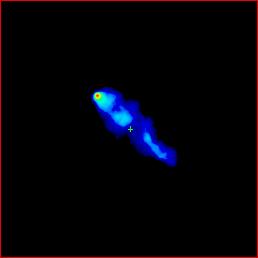 Image:
Image:3C 319 | B1522+546 |
| S178 | Alpha | FR | Class | ID | Spectrum | Best z | mag. | LAS | lg P178 | D |
|---|---|---|---|---|---|---|---|---|---|---|
| 16.7 | 0.90 | II | R+HB | Gal | 0.192 | R = 18.07 | 109.30 | 26.00 | 298.8 |

| Size: | 256.0 × 256.0 arcsec² |
|---|---|
| LUT: | Linear |
| Beam: | 4.0 arcsec |
| Frequency: | 1646 MHz |
| Method: | CLEAN Õ˜ÿ>4.0
|
| Telescope: | VLA B+C |
| Credits: | Leahy, Pooley & Riley (1986) |
Apart from the host, three other galaxies are projected within the radio lobes, but there is no sign that either the total intensity or polarization structure of the DRAGN is affected by them, so they are probably behind the lobes.
The radio structure is unusual in that although the north-east lobe has a normal hotspot at its end (seen at high resolution in the maps of Hardcastle et al), there is no sign of a hotspot or even "warmspot" at the end of the south-west lobe (which we therefore classify as relaxed). There is also no sign of a radio core. Since one of the other galaxies is projected close to the northern hotspot, it has been suggested that that is the true identification, making this a head-tail DRAGN. However, the identification with the central galaxy seems secure, based on the clear division into two lobes with a central brightness minimum (first shown by Bridle & Fomalont 1979), and the spectral index maps (Macklin 1983, Alexander & Leahy 1987) which show that both ends of the DRAGN have relatively flat spectra, with the spectrum steepening towards the centre as in typical classical doubles.
It has also been suggested (e.g. by Crane et al. 1983)
that the northern optical object is not
a galaxy, but synchrotron emission from the hotspot; however it is not
exactly coincident with the hotspot and in any case a spectrum
by Keel & Martini shows that almost certainly it is a galaxy.
| Prev. | Data Page | Other images | Next | Search | Alphanumeric List | Icon List | Atlas Index |
|---|